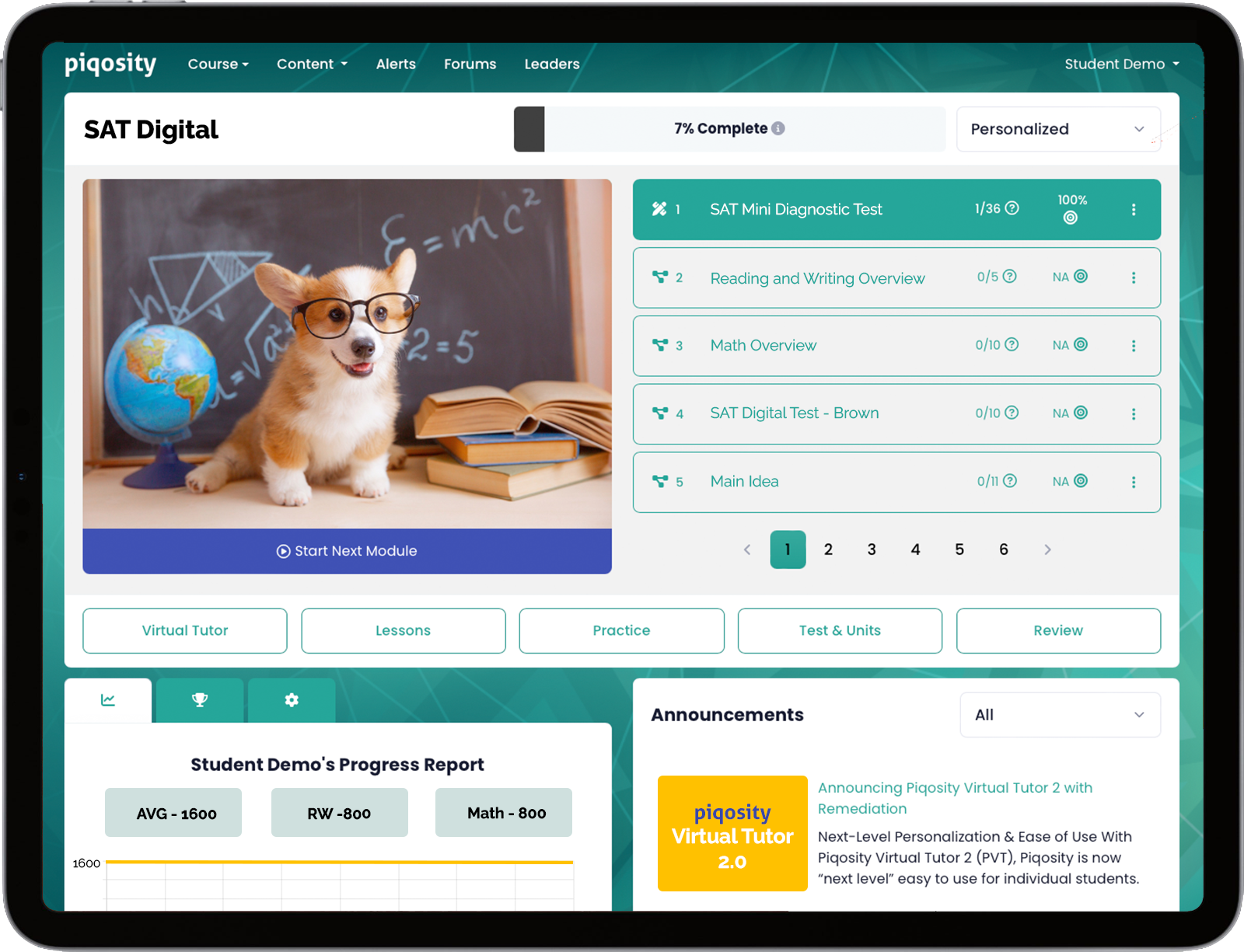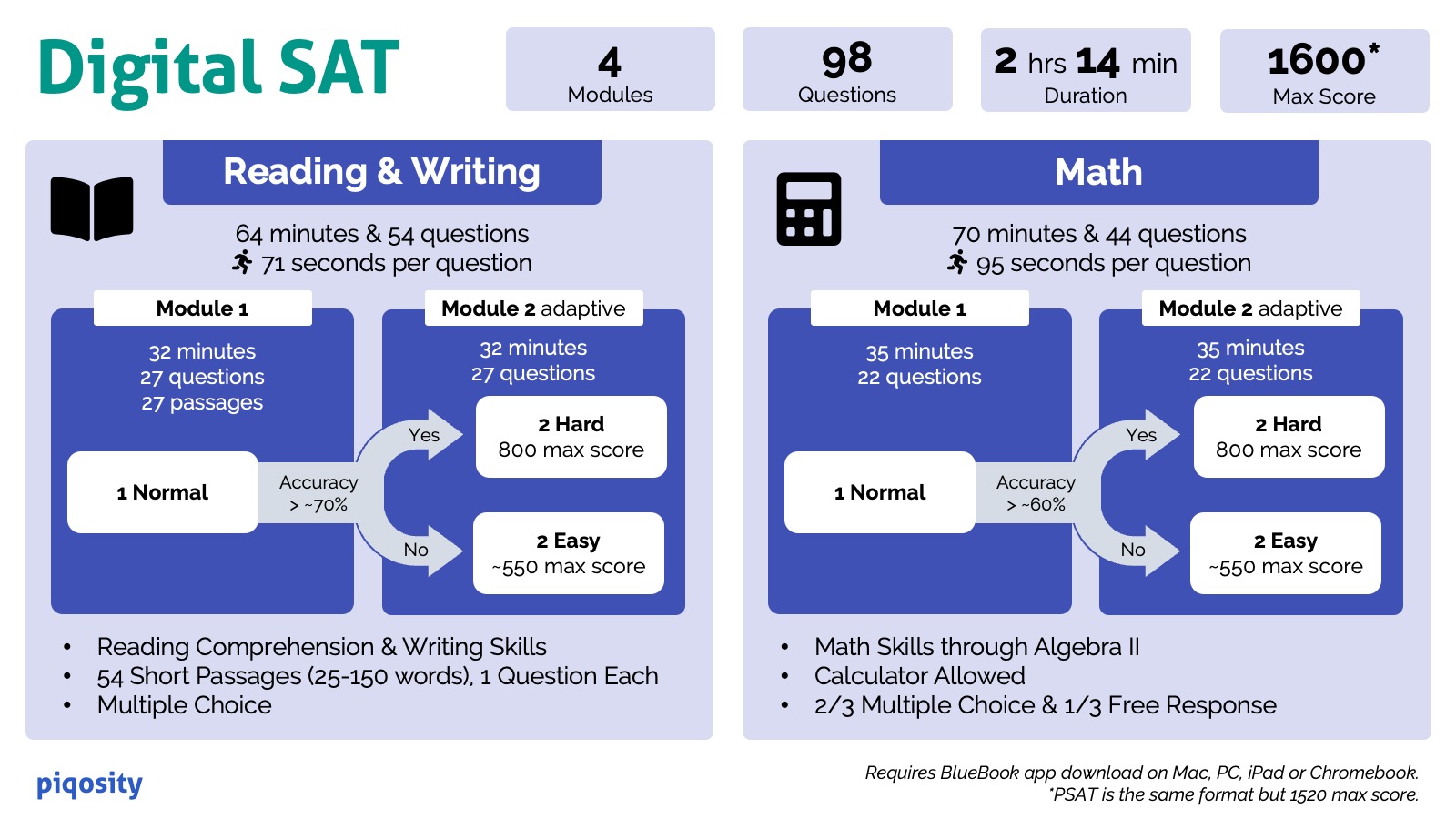
Piqosity offers 12 Digital SAT practice tests, and these tests are currently available for free! Just like the real Digital SAT, Piqosity’s full-length Digital SAT tests are comprised of 54 Reading and Writing Questions and 54 Math questions.
- No credit card or phone number required
- Full-length and adaptive
- Completely free through
MayAugust 24, 2024
The Digital SAT Reading and Writing test is divided into 2 modules. All students will take the mixed difficulty Reading and Writing module 1. Students who correctly answer 19 or more questions in module 1 will then go on to the harder Reading and Writing module 2b. Conversely, the majority of students will receive the easier Reading and Writing module 2a.
The Digital SAT Math test is also divided into two modules. All students will take the mixed difficulty Math module 1. Students who correctly answer 12 or more questions in Math module 1 will then go on to the harder Math module 2b. Conversely, the majority of students will receive the easier Math module 2a.
Our Digital SAT and Digital PSAT content is currently free while the course is under development. We are on a mission to be the world’s largest publisher of Digital SAT prep material by the summer of 2024:
- 12 full-length Digital SAT practice tests
- 2 Digital PSAT practice tests
- 1 mini-diagnostic Digital SAT practice test
- 1,800+ adaptive practice digital SAT questions
- 40+ instructional lessons including 10+ hours of video
- Step-by-step answer explanations for every question
Because the majority of SAT test preparation is spent brushing up on the tested concepts in math and English, our Digital SAT Advanced Plan will also include Intelligent Remediation and Piqosity Virtual Tutor to guide students through our accompanying math and ELA courses.
Piqosity Digital SAT Practice Test Publication Schedule
As of July 11, 2024, the following Digital SAT practice content is available for free:
- 1 Digital SAT Mini Diagnostic test
- 1 Digital PSAT 10/11
- 12 Digital SATs
- 1800+ Digital SAT practice questions
The remaining course content will go online through July and August:
- 1 more Digital PSAT 10/11 test(2 total) plus
- 2 Digital PSATs 8/9
- 5+ hours of video lessons
- 40+ text-based instructional lessons
Please note that the Digital SAT practice tests are currently listed in a random order and purposely not labeled 1-12. This naming convention is temporary during the free access period to ensure that we collect answer data for all 12 tests and norm them for difficulty.
Digital SAT Structure
Click here to download a black and white, printable version of this SAT infographic.
The new, digital SAT is comprised of two sub-tests:
- Reading and Writing – 64 minutes and 54 questions; 71 seconds per question
- Math – 70 minutes and 44 questions; 95 seconds per question
Each test is subdivided into two modules of equal question count and timed length:
- Module 1 – all students take this module
- Module 2 – hard or easy module
Module 2 is “adaptive,” in that about 75% of students will get the easier version and the highest scoring 25% will get the harder version:
- Reading and Writing 2b hard – accessible when you get about 70% of of Reading and Writing module 1 questions correct
- Math Writing 2b hard – accessible when you get about 60% of Math module 1 questions correct
Students must reach Module 2b in order to achieve the highest score on the SAT. Failure to make it to the harder module 2b results in a maximum score of about 1100 out of 1600.
Digital SAT Tested Content
Reading and Writing Test
- 27 passages per module
- 25-150 words in length
- 1 question per passage
- 71 seconds per question
- Wide range of genres including poetry
Tested reading and writing topics include:
- Information & Ideas – Main Idea & Supporting Idea
- Craft & Structure – Includes Vocabulary in Context
- Expression of Ideas – Conciseness & Precision
- Standard English Conventions – Grammar & Mechanics
Math Test
- 22 questions per module
- 95 seconds per question
- 2/3 multiple choice
- 1/3 type-in, free-response
- Calculator always allowed
Tested math topics include:
- Algebra (30%) – Pre-Algebra & Algebra I
- Advanced Math (30%) – Up through Algebra II
- Problem Solving & Data Analysis (15%)
- Geometry & Trigonometry (15%)
Free Educator Tools
If you’re a teacher tasked with preparing your class for the new, Digital SAT, Piqosity offers LMS features that will let you quickly monitor the progress of all your students including their weakest areas and timing. There’s no charge to access Piqosity for educators. Click here to learn more.




Leave A Comment